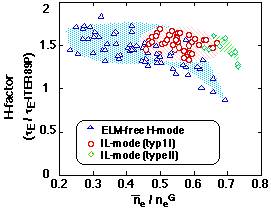
- Introduction of JFT-2M
- JFT-2M Tokamak
- Panorama of the Device
- Main Performance
- Current Research Subjects
- Collaborations
- Advanced material tokamak experiment program
- Development of new fuelling method
- Compact toroid injection: collaboration with HIT - - Study of improved confinement
- Heavy ion beam probe: collaboration with NIFS - - Study of closed divertor
- Disruption control study with ECH/ECCD
- Fast wave current drive study
Study of Closed Divertor
ITER Physics R&D on Divertor
Reduce heat load on divertor target and sustain high core confinement simultaneously
Objectives on the JFT-2M Divertor Study
- Achievement of dense and cold divertor together with high density H-mode by strong gas puffing
- Optimization of baffle structure to enhance the divertor pressure and reduce the neutral back flow.
Closed Divertor Concept in JFT-2M

- JFT-2M adopted the closed divertor configuration in 1995 prior to JT-60U. It has been modified to have the most closed baffle structure compared with other machines up to date.
- UEDA-code simulation is also used to optimize the divertor configuration.
Coexistence of Dense and Cold Divertor and Improved Confinement Mode
 |
 |
| Dense and cold divertor state progresses by strong gas-puff into divertor chamber. | Core plasma confinement does not degrade in the high density region up to  =0.7. =0.7. |
